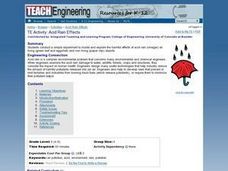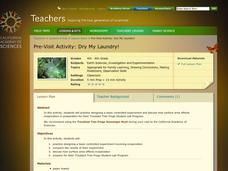Curated OER
Reflection and Refraction
What is a prism? A place for light waves that commit minor refractions! The thorough resource includes three hands-on investigations covering light reflection and refraction; mirrors, lenses, and images; and optical systems. Subject...
Michigan State University
Gases Matter
Young scientists learn that seeing isn't necessarily believing when it comes to the states of matter. After performing a fun class demonstration that models the difference between solids, liquids, and gases, children complete a series of...
Space Awareness
Let's Break the Particles
Build learning by breaking atoms! Young scientists study the way energy changes with a hands-on activity. As they roll steel marbles down a ramp, learners test the hypothesis that kinetic energy does not go away with friction or...
Space Awareness
Climate Zones
The climate at the equator is hotter than the climate at the poles, but why? The lesson plan goes in depth, explaining how the angles of illumination relate to the heating rate at different latitudes and seasons. Scholars use a strong...
Museum of Science
Virtual Heart
No more beating the pavement to find a virtual model of the human heart. See one in continual real-time motion, and layer it to highlight electrical impulses, blood flow, and valve activity.
Big Kid Science
Create a Milk Carton Camera to Observe the Eclipse!
Step aside, fancy glasses... it's time to create a solar eclipse viewing camera of your own using nothing more than a milk carton.
Curated OER
Water Resistance (1)
Get the class thinking about why particular objects and animals are shaped the way they are. Considering water resistance and shape, learners assess a series of images and how those objects function in water. They finish by conducting a...
Curated OER
This Can't be a Plant
Learners grow mold. In this science experiment lesson, students grow mold on different pieces of bread by adjusting the moisture, temperature, and light. They record the results to see which grows the most mold.
University of Georgia
Endothermic and Exothermic Reactions
Equip your chemistry class with the tools to properly understand endothermic and exothermic reactions. Young chemists collect, analyze, and graph data to determine how the Law of Conservation of Matter is applied to chemical composition...
Royal Society of Chemistry
Acids and Bases—Microscale Chemistry
Here's proof that small-scale labs lead to big-time learning. Introduce acid-base interactions to middle school scientists through a microscale chemistry lab. Pupils combine a variety of solutions and use indicators to obtain approximate...
Columbus City Schools
Changes All Around Us
Whoa! What just happened? That's right, change is everywhere. But what exactly is changing? Middle school science sleuths get to the bottom of the changes matter can experience. Through simple demonstrations, engaging videos, and an...
Curated OER
Got Light!
Sources of light, and the reflection of light off of objects, are the focus of this brief and simple science worksheet. Learners must trace the path that light takes which enables a boy to read a book. A suggested activity is to have the...
Curated OER
Digital Science through Pod Casting
Students create science presentations. In this science unit lesson, middle school students create a presentation on an elementary science concept. The presentations are turned into podcasts for the access of elementary school teachers.
Curated OER
An Egg-cellent Osmosis Experiment
Students investigate the problem of osmosis by conducting an experiment. They use eggs with the shells dissolved to tell whether fluid can move across the membranes. The experiment provides high interest for all kinds of students to keep...
Curated OER
Hummingbird Nests
Now here's a hands-on activity that little ones are sure to love. Using melted chocolate, coconut, and jelly beans they'll be able to shape tiny nests perfect for tiny birds. Kids love getting their hands dirty and the tactile experience...
Curated OER
Simple Atomic Structure
Atomic structure is reviewed with connection to the gain or loss of electrons. The movement of electrons and the resulting behavior is summarized. Practical uses of static electricity is explained, with diagrams of the most common...
Curated OER
Toting the Log and Lifting the Babe
Students use simple machines that demonstrate force, friction, work and power. They investigate and explain simple machines.
Curated OER
Cycles of Life in an Urban Habitat: Changes in Biodiversity
Second graders compare and contrast animate and inanimate objects. For this environmental science lesson, 2nd graders create simple food webs. They observe their environment and create a collage about it.
Curated OER
Environment: Banana-in-a-Jar Experiment
Students conduct experiments using bananas sealed in jars to observe the effects on biodegradable waste in landfills. They cover the lid with a plastic sandwich bag to create an airtight seal. Students observe how the oxygen is used...
Center for Learning in Action
Density
Explore the concept of density within states of matter—gases, liquids, and solids—through a group experiment in which young scientists test objects' texture, color, weight, size, and ability to sink or float.
Curated OER
Biotechnology Laboratory Research
Young scholars participate in an extended laboratory research to experience how scientific information is obtained, upon which we build scientific knowledge and understanding.
Curated OER
Acid Rain Effects
Get out the goggles and conduct a simple experiment to model and explore the harmful effects of acid rain (vinegar) on living (green leaf and eggshell) and non-living (paper clip) objects. Young chemists observe and describe the harmful...
Curated OER
Backyard Bacteria
Young scholars demonstrate safe ways to handle bacteria, prepare agar plates, and grow bacterial cultures. They identify different kinds of bacterial colonies, and devise a controlled experiment.
California Academy of Science
Dry My Laundry!
Meant to be a pre-field trip lesson plan, this can also serve as a cute and simple activity to use when your little ones are learning about evaporation or surface area. The children cut tiny t-shirts out of paper towel material, wet...

























